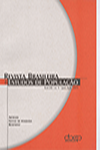Migrations and spatial dispersion of the population throughout areas of influence in the main metropolitan regions in Brazil
Keywords:
Migration, Spatial dispersion, Regions of InfluenceAbstract
An understanding of the second half of the 20th century is essential to any analysis of the spatial distribution of the Brazilian population. As part of a nationwide process of urbanization and industrialization, a large part of the population and its economic activities moved to the country’s metropolitan areas in just a few years. This process resulted largely from the dynamics of internal migrations, but since the late 1970s a number of authors have posited the hypothesis of a reversal in the polarization in Brazil, as described in models applied in developed countries. It is true that recurrent controversies on the subject have brought to the fore expressions such as “reversion of polarization,” “concentrated deconcentration, and “polygonal development.” The main objective of this study is to appraise the current magnitude of the spatial dispersion of the Brazilian population, based on areas of influence that surround the country’s largest metropolitan regions, as defined by the Brazilian Census Office (IBGE). The research was based on the 1991 and the 2000 Demographic Censuses, which made it possible to identify the migratory flows of the population. In general, the results were inconclusive for all the regions of influence. Nonetheless, in the specific case of São Paulo, the data related to inventories and flows, associated with the dimension of distance, indicate intensification in the occupation of spaces beyond the official boundaries of the metropolitan regions. The increased emigration to the region of influence of São Paulo seems to confirm a type of “polynucleated dispersion” with clear signs of expansion within the region of influence. This would seem to suggest a strengthening of certain regional centers and greater dynamism of local economiesDownloads
Downloads
Published
How to Cite
Issue
Section
License
Papers published in Rebep are original and protected under the Creative Commons attribution-type license (CC-BY). This license allows you to reuse publications in whole or in part for any purpose, free of charge, even for commercial purposes. Any person or institution can copy, distribute or reuse the content, as long as the author and the original source are properly mentioned.

